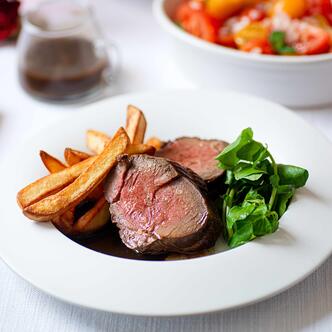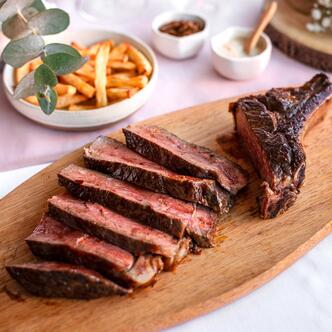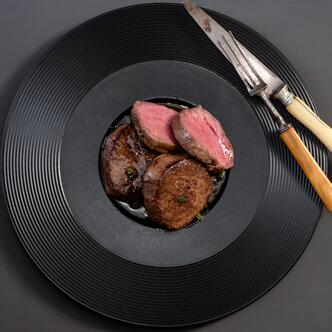
the definitive
Steak Guide
finding the right steak for you
As a general rule, fat means flavour so the more fat on the steak the more flavoursome the cut, but if tenderness is your thing, cuts with less fat are generally more tender with a softer texture. For an extra dimension, cooking on the bone also intensifies the flavour of the meat.
By choosing a Farmison & Co steak you'll Eat Better Meat, whatever your choice of cut. Our steaks are sourced from grass fed, heritage breeds, reared naturally and at their own pace for exquisite taste. The meat is then expertly butchered and dry-aged to further enhance its natural flavour.
sharing beef steaks


Chateaubriand
Chateaubriand


32 Day Dry Aged Sirloin Chop
32 Day Dry Aged Sirloin Chop

Thick Cut Rib Eye Steak - 32 Day Dry Aged
Thick Cut Rib Eye Steak - 32 Day Dry Aged


Thick Cut Sirloin Steak - 32 Day Dry Aged
Thick Cut Sirloin Steak - 32 Day Dry Aged


Côte De Boeuf - 32 Day Dry Aged
Côte De Boeuf - 32 Day Dry Aged
Meltingly Tender Beef Steaks


Chateaubriand
Chateaubriand


Fillet Steak
Fillet Steak


Côte De Boeuf - 32 Day Dry Aged
Côte De Boeuf - 32 Day Dry Aged


Rib Eye Steak - 32 Day Dry Aged
Rib Eye Steak - 32 Day Dry Aged
taste the difference
heritage breed steaks
The British Isles is home to some of the finest beef breeds in the world. In the past 50 years, a lot of these once popular brees have fallen out of favour as industrialised farming has taken over. Our mission is to return these to the nation's table, with a founding principle of Farmison & Co being that the more we demand them, the more farmers will rear them.
try a delicacy
old world beef
This is our great contribution to British cuisine and it might just be the most magnificent steak you've ever eaten. These cattle graze and forage for longer - anything between seven and ten years. In the process they imbue the qualitities of the local 'terroir.' The steaks are superbly marbled with an entirely unique flavour - perfect for the connoisseur.
what is
dry aged beef?
Experiences in taste and texture are what Farmison & Co is all about, providing high quality beef cuts and steaks that produce sensations on the palate and in the mouth. Restaurateurs are in no doubt and will without question always favour dry aged steaks are a constant delivery of class from grass. Farmison & Co want to bring the best quality of every type of meat and steaks and it's why we spend so much time and effort providing restaurant quality British beef cuts for home consumers.
consult our expert team
steak faqs
WHEN IS MY STEAK COOKED ?
How would you like your steak sir?
Blue: Should still be a dark colour, almost purple, and just warm. It will feel spongy with no resistance.
Rare: Dark red in colour with some juice flowing. It will feel soft and spongy with slight resistance.
Medium-rare: A more pink colour with a little pink juice flowing. It will be a bit soft and spongy and slightly springy.
Medium: Pale pink in the middle with hardly any juice flowing. It will feel firm and springy.
Well-done: Only a trace of pink colour but not dry. It will feel spongy and soft and slightly springy.
IS RESTING YOUR STEAK IMPORTANT AND WHY?
Given the time to rest the steak is imperative, the meat will lose less juice when you cut it and when you eat it the meat will be tastier.
The time taken to rest before carving a steak should be for a minimum of 5 minutes before serving or up to half the time of cooking, leave to rest on a wire rack in a warm place so as the meat doesn't go cold.
WHAT DOES 'CARVE AGAINST THE GRAIN' REALLY MEAN?
To maximize tenderness & ensure your steak is not too chewy it's imperative you slice against the grain. But why?
Meat is a muscle and it's designed to be tough, without muscles the cattle would not be able to move. A cow's muscle structure contains long strings of muscle cells known as fibers. One fiber as fine as a human hair. The challenge when eating is the fact that the fibers are bundled together, clusters as such of 50 or more.
These bundles create the "grain" of meat. You'll see the grain most pronounced in the toughest muscle groups, from the forequarter such as brisket, shoulder, shin & rump. Tender cuts, such as sirloin, fillet or rib eye, have fewer muscle fibers because they don't work as hard.
Remember if you don't cut the fibers crosswise 'against the grain' - regardless of the cut - you'll be chewing on longer, intact muscle fibers
When you cut across the grain, your teeth don't have to cut across the grain, Instead, you're biting smaller portions of muscle fibers so becoming more tender, so less chew!
Bone in steaks such as the Porterhouse and Tomahawk muscles are anchored to bones, and fibers tend to run parallel to the bone. So cutting crosswise to the bone is slicing against the grain.







